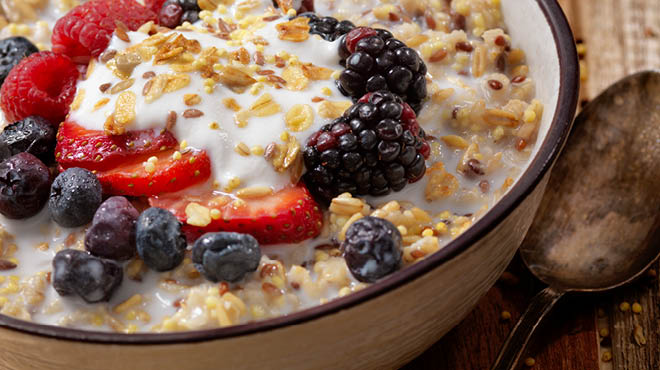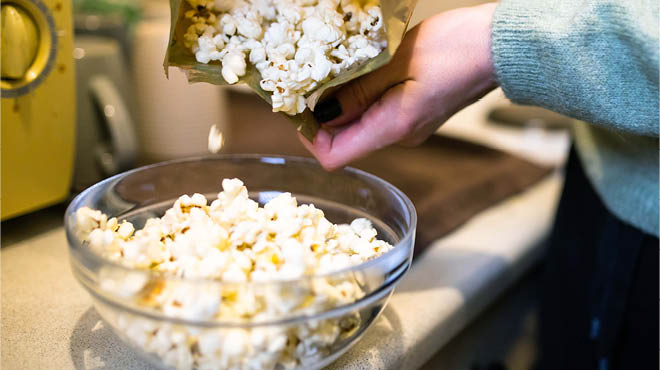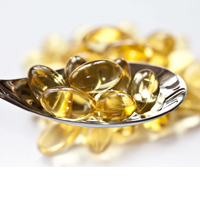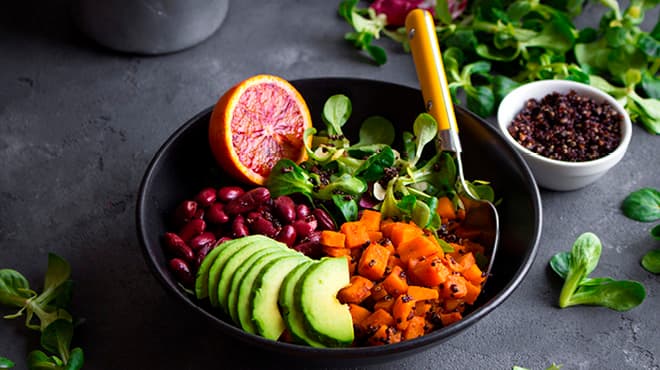Recent Posts
-
 Speaking of HealthFrom inflammation to heart health: The perks of pumpkin in your dietNovember 04, 2024
Speaking of HealthFrom inflammation to heart health: The perks of pumpkin in your dietNovember 04, 2024 -

-

Are you mindlessly munching or sensibly snacking?

When you snack correctly, it can boost your energy between meals, help you meet nutrient needs for the day and keep hunger at bay to prevent you from overeating at the next meal. Managing your appetite can help you maintain a healthy weight and reach weight-loss goals.
Snacking tips
- Plan your snacks.
Keep a variety of nutrient-rich, ready-to-eat foods nearby to snack on when hunger hits. This will help lessen the temptation of less healthy options from vending machines, break rooms or convenience stores. Ideas include fresh fruit, air-popped popcorn, fat-free or low-fat yogurt, and nut mixes. - Snack for hunger, not because of stress or boredom.
It's typical to be hungry three to four hours after a meal. When you feel hunger setting in, ask yourself, "Am I physically hungry, or am I bored, stressed or frustrated?" before you grab a snack. If you're experiencing physical hunger, it's time to grab a satisfying snack. If boredom or stress are prompting you to snack, try doing another activity, such as going for a walk. - Make snacks count.
Choose nutrient-dense foods that will help fill the gaps in your eating plan. Focus on incorporating whole foods, such as fruits, vegetables, whole grains and low-fat dairy products. Try to combine carbohydrates, protein and fat for long-lasting, satisfying snacks. Choose these options rather than packaged items high in calories, fat and sodium, such as chips, candy or cookies. - Snack on sensible portions.
To keep portion sizes in check, purchase single-serve containers or put small servings of snacks into a bowl rather than eating them directly from the package. Eating out of a package often can lead to mindless eating and result in eating more than intended. Aim for snacks that have less than 200 calories.
Snacking suggestions
A variety of snacks can fit into your healthy lifestyle choices. With some planning, you can easily choose low-calorie, nutrient-dense options.
Look for snacks in these areas:
- Whole grains
Whole grain snacks include energy from carbohydrates and are a good source of fiber. Choose low-fat, whole-grain crackers; air-popped popcorn without added butter; or whole-grain snack bar without added sugars. One slice of whole-grain bread and one ounce of low-fat protein, like turkey or chicken, is another good choice. - Dairy foods
Dairy foods are an excellent source of calcium and protein. Low-fat versions keep the calorie count lower, too. Cheese, yogurt and milk are good options. Limit cheese to a 1-ounce serving and milk and yogurt to a 1-cup portion per snack. - Fruits
Fruits are full of vitamins and minerals and don't contain fat. A typical serving of fresh, frozen or canned fruits only has about 60 calories. If you choose canned fruit, look for items packed in 100% fruit juice to eliminate extra calories from syrup. - Vegetables
Vegetables contain fiber, which makes them filling. They're packed full of vitamins and minerals and are low in calories. Raw veggies can help you tackle a snack craving when paired with salsa or low-fat dips. - Proteins
Nuts and seeds are a good source of protein to help you feel full longer. They also contain heart-healthy fats. Nuts and seeds are high in calories, so pay attention to the serving size.
Try these snack ideas that incorporate healthy ingredients:
- 1 tablespoon peanut butter and slices of medium apple
- Small banana and 16 almonds
- 1/4 cup mashed avocado and whole-grain toast
- 3/4 cup plain Greek yogurt and 1 cup berries
- 6 whole-wheat crackers and 1 ounce of cheese, typically one slice
- One 6-inch whole-wheat tortilla, 1/4 cup black beans and 2 tablespoons salsa
- 10 baby carrots and 2 tablespoons hummus
- 3 cups air-popped popcorn sprinkled with 3 tablespoons grated parmesan cheese
- Pear and string cheese
- 1 cup plain oatmeal and 1/2 cup mixed berries
Chickpeas are a high-protein, low-fat, high-fiber food perfect for sensible snacking. Give these recipes a try:
Sweet and spicy snack mix
From Mayo Clinic
Swap out traditional peanuts and pretzels for this chickpeas and dried fruit mix to reduce fat and sodium and increase fiber.
2 15-ounce cans of chickpeas, rinsed, drained and patted dry
2 cups unsweetened wheat squares cereal
1 cup dried pineapple pieces
1 cup raisins
2 tablespoons honey
2 tablespoons Worcestershire sauce
1 teaspoon garlic powder
1/2 teaspoon chili powder
Heat the oven to 350 degrees F. Lightly coat a large baking sheet with butter-flavored cooking spray.
Generously spray a heavy skillet with butter-flavored cooking spray. Add chickpeas to the skillet and cook over medium heat, stirring frequently until they begin to brown, about 10 minutes. Transfer the chickpeas to the prepared baking sheet. Spray the chickpeas lightly with cooking spray. Bake, stirring frequently, until crisp, about 20 minutes.
Lightly coat a roasting pan with butter-flavored cooking spray. Measure the cereal, pineapple, raisins and pour them into the pan. Add the roasted chickpeas. Stir to mix.
Combine honey, Worcestershire sauce, and spices in a bowl. Stir to mix evenly. Pour the liquid mixture over the ingredients in the roasting pan and toss gently. Coat the mixture again with the cooking spray. Bake for 10 to 15 minutes, stirring occasionally to keep the mixture from burning.
Remove from the oven and let cool. Store in an airtight container.
Nutrition information per 1/2-cup serving: 172 calories, 1 gram total fat, trace saturated fat, 0 milligrams cholesterol, 197 milligrams sodium, 38 grams carbohydrates, 5 grams fiber, 3 grams sugars, 5 grams protein.
Roasted red pepper hummus
From Mayo Clinic
2 cups of canned chickpeas, rinsed and drained
1 cup roasted red bell pepper, sliced and seeded
2 tablespoons white sesame seeds
1 tablespoon lemon juice
1 tablespoon olive oil
1 1/4 teaspoons cumin
1 teaspoon onion powder
1 teaspoon garlic powder
1 teaspoon kosher salt
1/4 teaspoon cayenne pepper
In a food processor, blend all ingredients until smooth. Store in an airtight container. Hummus can be kept in the refrigerator for up to one week.
Nutrition information per 3 tablespoon serving size: 45 calories, 2 grams total fat, trace saturated fat, 0 milligrams cholesterol, 190 milligrams sodium, 6 grams carbohydrates, 2 grams fiber, 2 grams sugars, 2 grams protein.
Allie Wergin is a registered dietitian nutritionist in New Prague, Minnesota.



